Categorias
Latas de Segurança do Tipo I e Tipo II
As nossas latas e recipientes de segurança oferecem armazenamento seguro para líquidos inflamáveis para ambientes de trabalho. Com as nossas latas de segurança, os riscos de acidentes e incêndios são minimizados, protegendo as pessoas e resultando num local de trabalho mais seguro. As latas e recipientes de segurança da Justrite foram concebidos tendo em mente os códigos de segurança para cumprir uma variedade de regulamentos de segurança diferentes.
Ler mais
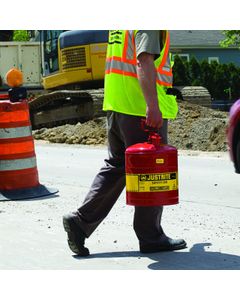
Latas de Segurança do Tipo I 1001 Justrite recipientes de segurança Amarelo Gatilho
Proteja os trabalhadores e reduza os riscos de incêndio transferindo, armazenando e distribuindo líquidos inflamáveis em recipientes de segurança do tipo I com bico único e aprovadas pela OSHA.
Disponível em 4 versões

Latas de Segurança do Tipo I 1001 Justrite recipientes de segurança Vermelho Gatilho
Proteja os trabalhadores e reduza os riscos de incêndio transferindo, armazenando e distribuindo líquidos inflamáveis em recipientes de segurança do tipo I com bico único e aprovadas pela OSHA.
Disponível em 5 versões
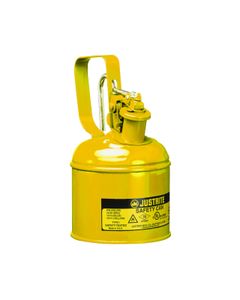
Latas de Segurança do Tipo I 1001 Justrite recipientes de segurança Amarelo Manípulo do gatilho
Proteja os trabalhadores e reduza os riscos de incêndio transferindo, armazenando e distribuindo líquidos inflamáveis em recipientes de segurança do tipo I com bico único e aprovadas pela OSHA.
Disponível em 2 versões
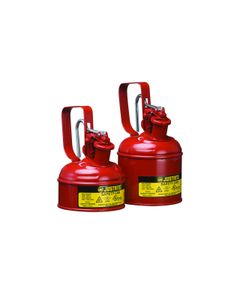
Latas de Segurança do Tipo I 1001 Justrite recipientes de segurança Vermelho Manípulo do gatilho
Proteja os trabalhadores e reduza os riscos de incêndio transferindo, armazenando e distribuindo líquidos inflamáveis em recipientes de segurança do tipo I com bico único e aprovadas pela OSHA.
Disponível em 3 versões
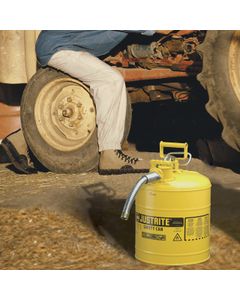
Latas de Segurança do Tipo II AccuFlow™ 1002 Justrite recipientes de segurança Amarelo
Vá mais além na proteção e na conformidade com a conveniência adicional de AccuFlow™ com o gatilho Safe-Squeeze® para segurança e controlo no vertimento
Disponível em 5 versões
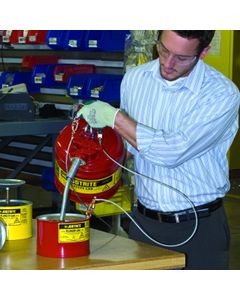
Latas de Segurança do Tipo II AccuFlow™ 1002 Justrite recipientes de segurança Vermelho
Vá mais além na proteção e na conformidade com a conveniência adicional de AccuFlow™ com o gatilho Safe-Squeeze® para segurança e controlo no vertimento
Disponível em 6 versões
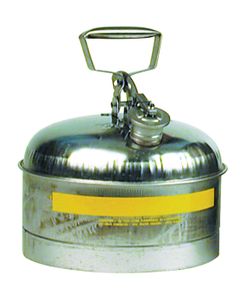
Recipientes em Aço Inoxidável do Tipo I 133CN Eagle
Type I stainless steel safety cans are constructed of sturdy 24 gauge type 316 stainless steel with a stainless steel flame arrestor.
Disponível em 2 versões
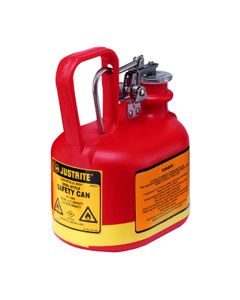
Latas de Segurança de Polietileno do Tipo I 1406 Justrite recipientes de segurança
As latas de PEAD resistentes a produtos químicos proporcionam armazenamento seguro para produtos corrosivos inflamáveis com um design de poupança de espaço
Disponível em 5 versões
FAQ about Latas de Segurança do Tipo I e Tipo II
What is the difference in a Type I & Type II Safety Can?
The Type I Safety Can has one opening that serves for both filling and dispensing. The Type II Safety Can has one opening dedicated to filling and a second spout opening dedicated to dispensing. The Type II Safety Can comes with an attached flexible hose and our exclusive AccuFlow™ manifold with Safe-Squeeze® trigger handle to provide the smooth and controlled pouring.
Can I transport gasoline in a safety can in my vehicle?
Yes, you can transport a safety can in a vehicle. Important points:
Secure safety can from movement.
Make sure the vehicle is well ventilated.
Do not store a safety can in a vehicle.
Take a safety can out of the vehicle when filling or dispensing.
Clean any fuel off the safety can before returning it to the vehicle
Are safety cans OK for outdoor use?
You most certainly can use safety cans outdoors. A lot of our customers do. There are some precautions to take with a safety can as well as any other container when outdoors:
1. When temperatures are hot, the vapor pressure in any safety can will be elevated. Safety cans are design to emergency pressure relief, rated at 3 to 5 psi. Still 3 to 5 psi can be significant. It is important to relieve that pressure in vapor space (while a safety can is setting flat) rather than liquid space (when tilted and dispensing liquid) to avoid a sudden burst of fluid and back splash.
2. When the temperature is warm and there is a sudden cooling, vacuum in the safety can will be created. There is no vacuum relief valve built into a safety can. While rare and depending on the fluid level in the safety can, the vacuum created can implode a safety can. This is more prevalent in desert locations. There are a couple of things you can do to prevent this:
Burp your safety cans at the end of the day to relieve pressure. The less difference in pressure, the less likely an implosion will occur.
Keep your cans shaded or tarped to minimize the temperature gain and pressure gain in the can.
Keep your safety can’s fluid level above half full.
3. Keeping your safety can in the shade can also minimize material loss. Gasoline as an example will boil at 100 degrees Fahrenheit. The pressure escaping is a liquid’s vapor escaping.
4. Always keep a safety can in a well-ventilated area. Never in a closed vehicle or passenger space.
5. And safely secure a safety can against movement in a vehicle from sudden braking or centrifugal forces.
6. Remember the US DOT’s material of trade rule as it applies to transporting gasoline in the course of performing one’s job; you are allowed a maximum of eight gallons in safety cans (i.e. 4 ea. 2 gal. safety cans).
7. Our metallic safety cans have a raised bottom to protect the bottom from puncture of sharp rocks and reinforcing ribs for resistance against side impacts.
¿Puedo almacenar nitrógeno líquido en una lata de seguridad?
Los materiales como el acero al carbón, el plástico y el caucho se vuelven quebradizos a temperaturas extremadamente bajas. El nitrógeno líquido se almacena en contenedores resistentes a impactos y especialmente aislados, que están ventilados para evitar la acumulación de presión. Esta gama de latas de seguridad NO está diseñada para almacenar nitrógeno líquido.






